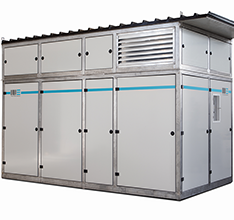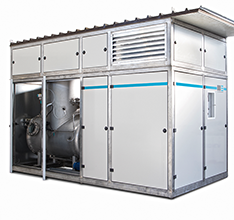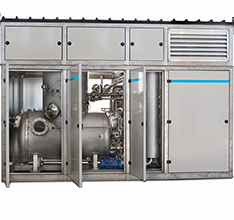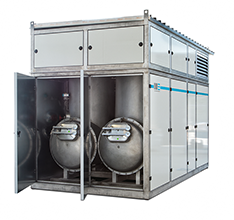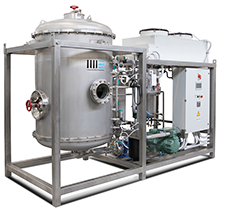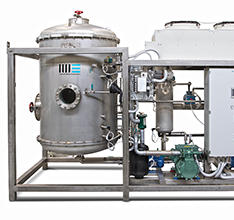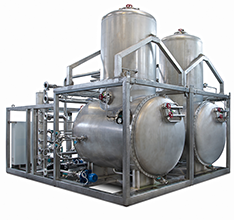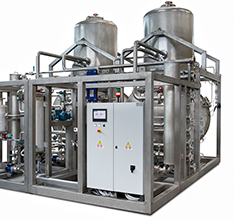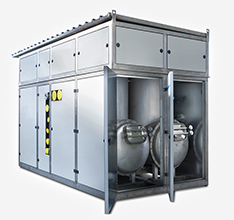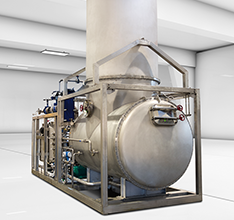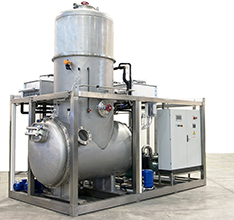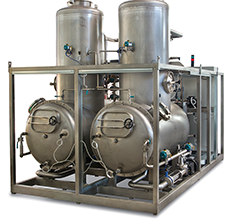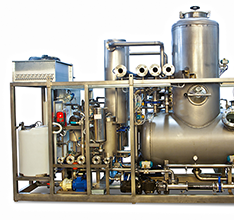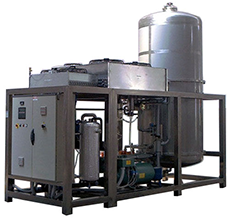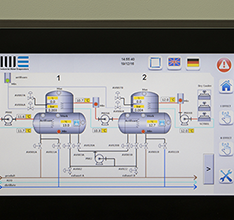OTHER PLANTS
VACUUM EVAPORATORS
FOR PURIFICATION AND REUSE OF INDUSTRIAL WASTE WATER
these years a more and more considerable importance an always more considerable importance has assumed in these years forcing in many cases the companies to study carefully the companies in many cases to study solutions which allow either to reduce the most possible costs bound to the treatment or the disposal of waters or to reuse them inside its productive cycle. Unfortunately in the greater part of the cases these solutions turn out too much onerous (addressing towards one investment policy in along term) and often they don’t give the guarantees necessary to consider the choice convenient and sure. In effects a fit search of possibilities offered from the present market leaves to realize that in the specific case of the waters’ treatment, simple, effective and economic solutions exist. From always the evaporation is well-known as the only natural process that split water from a compound that does not imply the happening of any external chemical or physical reaction. Like well-known, the ebullition of the water (therefore its evaporation) is a phenomenon bound to the relationship between temperature and pressure due to both in way directly proportional; consequently it is clear that, to ambient pressure, the temperature of ebullition will be around to the 100°C, but operating in a vacuum atmosphere it will come down proportionally to the caught up residual pressure. The technology used from the vacuum evaporators takes advantage of this physical law in order to carry to boiling a liquid to low temperature working in a vacuum atmosphere.
Just thanks as simple as effective principle applied by our evaporators, the fields of application where to be able to use these machines are multiple: galvanic industry, die castings, mechanical industry, aluminium’s surface treatment, paintings, dyeworks, printing dye-house, gold jewellery, pharmaceutic and cosmetic industry, oenology, oil-works or in the same landfills in order to put into effect the concentration of the disposal. According to the applications the body boiler and the exchangers can be realized in stainless steel AISI 316, SANICRO-28, Titanium, Hastelloy, Incolloy, SAF 2507 – Super Duplex, etc.
HEAT PUMP EVAPORATORS
The system consists of a vacuum autoclave (pressure –960 mBar) divided in one boiling section for the evaporation of the product at low temperature (30° C) and one condensation section. The heat pump circuit consists of a compressor at electric driving that compresses the freezing gas freon at 60°C into the immersed exchanger, causing the ebullition and the evaporation of the wastewater to treat. On leaving the exchanger, the gas flows through the undercooler and vaporizes by an expansion valve into the condensation exchanger. During the expansion process, the gas absorbs heat making so possible the condensation of the steam risen through the central chimney. An extraction pump extracts the condensed steam, which is concentrated on the bottom of the chamber, and stores it in the vacuum service tank. A discharge pump discharges automatically the concentrate, once reached the set concentration, without any working interruption.
HEAT PUMP EVAPORATORS
This type of system, uses the same technology of Vs series, introducing however scarcely different structural characteristics. The refrigerating cycle, and that for the distillate extraction are the same while the substantial difference is in the conformation of the chamber of ebullition/condensation. In this type, the zone of steam condensation, is placed alongside of the boil body to exploit the evaporation mirror to the maximum (the useful height between boil’s zone and that of condensation) therefore minimizing any draggings in order to obtain a better distillate quality.
HEAT PUMP EVAPORATORS WITH SCRAPERING
In the family of heat pump evaporators, there is a typology with "scrapering device" which allows to obtain higher concentrations without compromising the good machine working caused by any residual stores of viscous or scaling products. In this case the ebullition chamber is completely free as the thermic exchange surface is outside. During the concentration phase the rotation of a few scraping shovels on the internal walls, keeps constantly clean the heating surface and the same movement is tending to amalgamate the concentrated not leaving it to harden excessively.
HEAT PUMP EVAPORATORS DRY SERIES
In other cases the requirements dictated from the final destination of the concentrated one, that is eventual re-use, can suggest the employment of an evaporator DRY. This type is only a heat pump evaporator with horizontal ebullition’s chamber and the heating surface outside (like the scraping) that allows to push the concentration until to be dried. In effects, the treated product always finds to contact with the lined exchanger, obtaining constantly the heat necessary to cause the ebullition. Moreover the same conformation of the machine allows to extract whichever type of residual easy, independently from its condition.
HOT WATER EVAPORATORS MULTI-STAGE
The choice of a hot water concentrator becomes still more convenient when within the activity’s sphere it’s verified the availability of heat’s sources to low cost or quite the possibility to recover heat from the production process (hot water from co-generation systems, returns of condense, waters of cooling, thermic recovery from fumes, etc.). The hot water concentrator can be composed by one or more stages according to the temperature of the primary heating fluid, and according to the liquid to be treated. In the multistage version, the heat transferred to the evaporate product, is completely recycled in following stages, producing a “cascading” effect. In effects, the energy absorbed from a system to three stages is approximately 1/3 of that demanded from a system mono-stadium of equal productive potentiality. The condensation of the distillate at the final stage happens by a special condenser with closed circuit and does not require water (except for a very small quantity for recovery). An other great obtainable advantage from this system is given from the possibility to add an ulterior module (up to three) increasing therefore productive efficiency without particular installation burdens and without increase of energy supply. The particular assembling characteristics of our DPM series and the lack of frigorific circuits or sophisticate devices guarantee a safety working and lower maintenance respect to all other concentration system.










